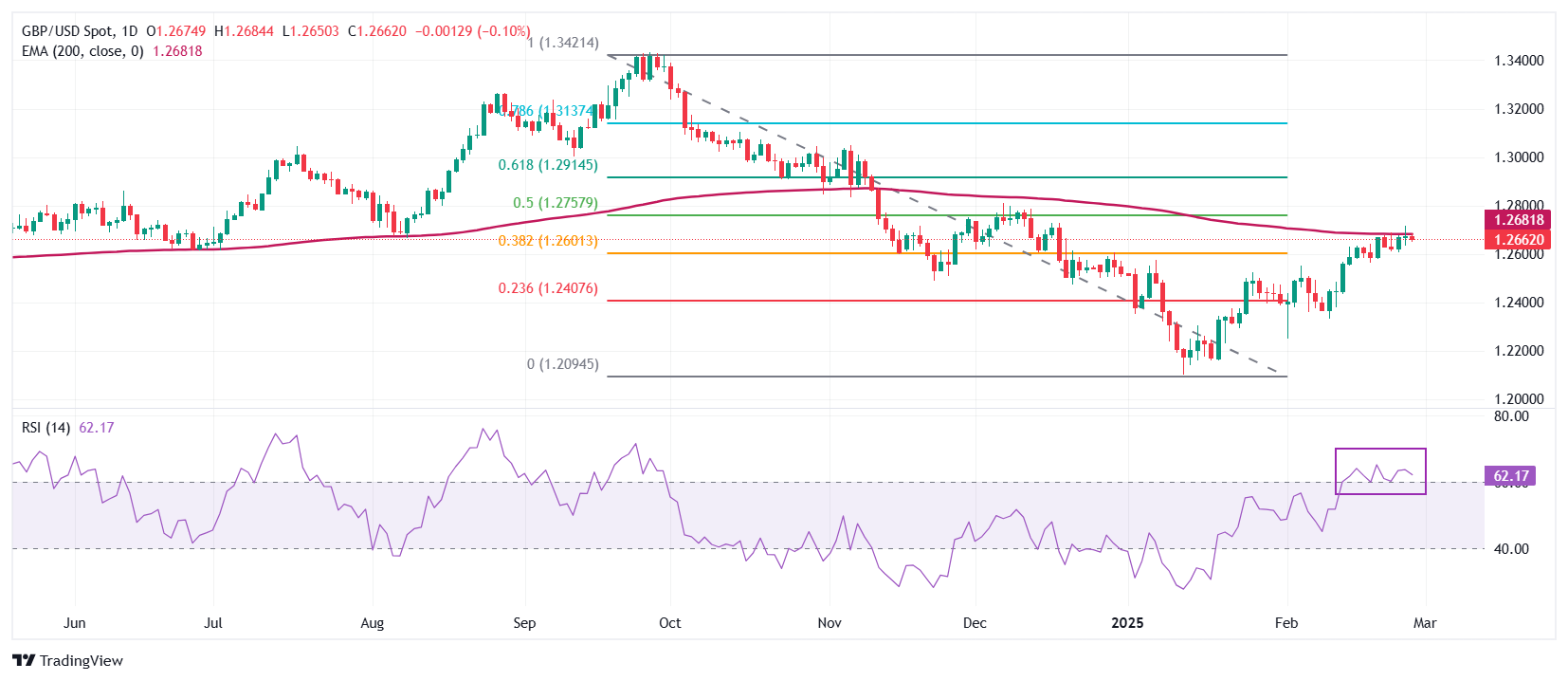- The Pound Sterling falls to near 1.2650 against the US Dollar as market sentiment is cautious due to uncertainty over the global economic outlook.
- President Trump said that he will unveil details of tariffs on the Eurozone soon.
- Investors await the Trump-Starmer meeting and the US PCE inflation data.
The Pound Sterling (GBP) trades cautiously against its major peers on Thursday as investors await the outcome of United Kingdom (UK) Prime Minister Keir Starmer’s meeting with US President Donald Trump on Thursday. Starmer is expected to negotiate on trade policies between both nations.
Investors will pay close attention to Trump-Starmer’s meeting, given that the UK is the fifth largest trading partner of the US after Canada, Mexico, China, and Germany, according to data from the US Bureau of Economic Analysis (BEA).
Trump-Starmer talks on trade policies are expected to be healthy as Trump has never raised any issue regarding unfair trade practices by the UK in his tariff threats since the election campaign. Also, President Trump said in a press conference earlier this month that he is not sure about imposing tariffs on the UK and was confident that a deal could be made as Prime Minister Keir Starmer has been “very nice”.
Meanwhile, UK Chancellor of the Exchequer Rachel Reeves is confident that trade and investment between the US and the UK would not be derailed by the new US administration. “The last time President Trump was in the White House, trade and investment flows between our two countries increased, and I’ve got every confidence that that can happen again,” Reeves said in an interview with Reuters at the sidelines of the G20 Finance Ministers’ summit.
British Pound PRICE Today
The table below shows the percentage change of British Pound (GBP) against listed major currencies today. British Pound was the strongest against the Japanese Yen.
| USD | EUR | GBP | JPY | CAD | AUD | NZD | CHF | |
|---|---|---|---|---|---|---|---|---|
| USD | 0.06% | 0.00% | 0.42% | -0.12% | 0.03% | 0.19% | 0.31% | |
| EUR | -0.06% | -0.06% | 0.36% | -0.19% | -0.02% | 0.13% | 0.25% | |
| GBP | -0.00% | 0.06% | 0.40% | -0.13% | 0.02% | 0.19% | 0.30% | |
| JPY | -0.42% | -0.36% | -0.40% | -0.56% | -0.40% | -0.27% | -0.13% | |
| CAD | 0.12% | 0.19% | 0.13% | 0.56% | 0.16% | 0.32% | 0.42% | |
| AUD | -0.03% | 0.02% | -0.02% | 0.40% | -0.16% | 0.17% | 0.26% | |
| NZD | -0.19% | -0.13% | -0.19% | 0.27% | -0.32% | -0.17% | 0.11% | |
| CHF | -0.31% | -0.25% | -0.30% | 0.13% | -0.42% | -0.26% | -0.11% |
The heat map shows percentage changes of major currencies against each other. The base currency is picked from the left column, while the quote currency is picked from the top row. For example, if you pick the British Pound from the left column and move along the horizontal line to the US Dollar, the percentage change displayed in the box will represent GBP (base)/USD (quote).
Daily digest market movers: Pound Sterling drops against US Dollar as Trump’s tariff threats prompt risk-off mood
- The Pound Sterling falls to near 1.2650 against the US Dollar (USD) in European trading hours on Thursday. The GBP/USD pair faces pressure as investors rush to safe-haven assets due to uncertainty over United States (US) President Donald Trump’s tariff agenda. The US Dollar Index (DXY), which tracks the Greenback’s value against six major currencies, moves higher to near 106.70.
- On Wednesday, US President Donald Trump said he is prepared to announce tariffs on the Eurozone. “Details on EU tariffs coming soon”, Trump said. He added that tariffs to be 25% on autos and other things. Though the foundation of a global trade war has already been laid by Trump imposing 10% tariffs on all imports from China, higher import duties on the 27-nations bloc would escalate fears of an economic slowdown across the globe.
- Meanwhile, Donald Trump has provided a further month-long extension to Canada and Mexico to avoid tariffs. “Canada and Mexico tariffs to go into effect on April 2”, Trump said. Earlier, the deadline for slapping levies by the US on its North American partners was February 4, which was postponed to March 4 after they agreed to tighten border securities to restrict the flow of fentanyl and undocumented immigrants into the economy.
- On the domestic front, the outlook of the US Dollar appears to be losing strength due to a contraction in the S&P Global US Services Purchasing Managers Index (PMI) for the first time in more than two years and a big slump in the Consumer Confidence data for February. Weak economic data has also boosted expectations that the Federal Reserve’s (Fed) restrictive policy stance won’t last long. According to the CME FedWatch tool, there is a 68% chance that the Fed can reduce interest rates in the June policy meeting.
- For more guidance on the Fed’s policy outlook, investors will focus on the US Personal Consumption Expenditures Price Index (PCE) data for January, which will be released on Friday. In Thursday’s session, investors will pay close attention to the US Durable Goods Orders data for January, the Initial Jobless Claims for the week ending on February 21, the updated Gross Domestic Product (GDP) report for the last quarter of 2024, and Fed policymakers Michael Barr, Michelle Bowman, Thomas Barkin, Beth Hammack, and Patrick Harker speeches.
Technical Analysis: Pound Sterling faces presure near 200-day EMA

The Pound Sterling drops to near 1.2650 against the US Dollar in Thursday’s European session. The GBP/USD pair continues to face pressure near the 200-day Exponential Moving Average (EMA), which trades around 1.2680. The Cable holds above the 38.2% Fibonacci retracement from the end-September high to the mid-January low downtrend around 1.2620.
The 14-day Relative Strength Index (RSI) oscillates above 60.00. The bullish momentum remains intact if the RSI (14) holds above that level.
Looking down, the February 11 low of 1.2333 will act as a key support zone for the pair. On the upside, the 50% and 61.8% Fibonacci retracement at 1.2767 and 1.2927, respectively, will act as key resistance zones.
Economic Indicator
Core Personal Consumption Expenditures – Price Index (YoY)
The Core Personal Consumption Expenditures (PCE), released by the US Bureau of Economic Analysis on a monthly basis, measures the changes in the prices of goods and services purchased by consumers in the United States (US). The PCE Price Index is also the Federal Reserve’s (Fed) preferred gauge of inflation. The YoY reading compares the prices of goods in the reference month to the same month a year earlier. The core reading excludes the so-called more volatile food and energy components to give a more accurate measurement of price pressures.” Generally, a high reading is bullish for the US Dollar (USD), while a low reading is bearish.






